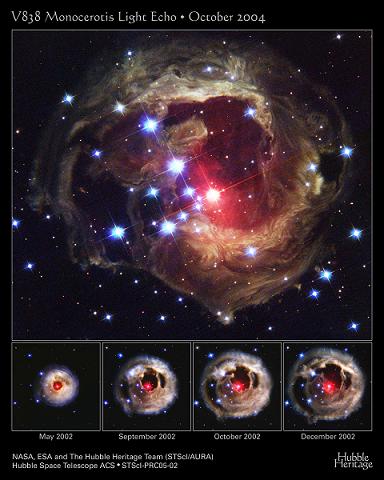This is what Dr. Alon Reter, an Israeli scientist who is in a postdoctoral position at the University of Pennsylvania, claims at a scientific conference held about two weeks ago in Spain
The scientist, Dr. Alon Rater

At the beginning of 2002 the star Mon V838 erupted, within a few days the intensity of its light increased 600,000 times, and for several months it was the brightest star in the Milky Way galaxy. Different types of stars are known to explode from time to time, even with stronger intensities, but it quickly became clear to astronomers observing Mon V838 that this event was fundamentally different from the known explosions. First, the star's light curve showed three peaks, suggesting that the outburst was in three stages. Secondly, around the star a spectacular light echo was discovered, which results from the reflection of the light of the eruption from dust and gas that are around the star or on the path between the observers and the star. The Hubble Space Telescope took spectacular pictures of the star, and followed the evolution over time of the light echo. In addition, during the eruption, the star expanded to enormous dimensions, about 15 times the distance between the Sun and Earth, after which it became one of the coldest stars in the galaxy. These data led the researchers to conclude that V838 Mon indicates a new type of starburst. The question of what caused the eruption, which actually happened far away from us about 20,000 years ago, is considered the most important puzzle today in the evolution of stars.
The mysterious eruption of the star has aroused the interest of many scientists from all over the world. A lot of data has been collected on it, and several explanations have been proposed for this new phenomenon. Some of them used variations of known phenomena in the evolution of stars. Another pair of researchers, Prof. Noam Sokar from the Technion and Prof. Remaul Tilanda from Poland, suggested that a fatal collision between two stars caused the eruption. Another very fascinating explanation was given in 2003 by two Israeli astrophysicists who were then at the University of Sydney in Australia. Dr. Alon Reter and Dr. Ariel Marom proposed that the eruption of Mon V838 was caused by the natural expansion of the star which caused it to swallow three nearby massive Jupiter-like planets.
We note that towards the end of their lives, the nuclear burning in the center of stars like the Sun weakens. This phenomenon causes serious expansion, the radius of the star increases tens and hundreds of times, and the star becomes a cold red giant. The researchers believe that our sun will not escape a similar fate, and that during its expansion it will swallow the planet Mercury, Venus, and possibly the Earth as well. Worried readers can relax, this will only happen in about 4.5 billion years. The phenomenon of planets being swallowed by stars has been studied in the past by a number of scientists, including the Israeli astrophysicist Prof. Mario Livio, who is staying at the Hubble Space Center located in Baltimore.
About two weeks ago, a conference was held on the Spanish island of La Palma, in the Canary Islands, dedicated to the star Mon V838 and similar phenomena. In an invited lecture, Dr. Alon Reter, who is now at Penn State University, reviewed his model and that of his research partners. Dr. Retter summarized additional calculations of the phenomenon of swallowing the planets, and concluded that the planets stop deep inside their parent star - at a distance of about one solar radius from the center of the giant swallowing star. Dr. Retter offered another possibility for the three peaks in the light curve of the star Mon V838, and claimed that they may be related to three stages in the fall of one planet, like a ball bouncing and falling down stairs. The conference closed with the agreement that additional observations of the star and other similar objects are needed to learn more about the phenomenon, and at the beginning of planning another conference on the subject to be held in a few years.
